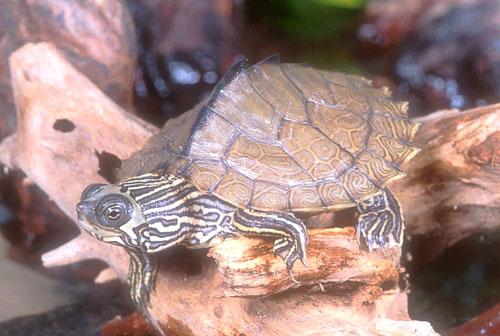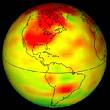Map Turtle
Scientific Name: Graptemys
Mon, 28th April, 2025 - 9:33 am GMT
Sponsor Ads:

Alternative Name
Scientific Name: GraptemysBasic Info
A moderately sized turtle, female Map Turtles are significantly larger than males. The thin lines on their skin and sides are reminiscent of a road map, which is where the turtle derives its name. The majority of Map Turtles have a raised ridge, or keel, which runs across the middle of their upper shell. This keel has, on many species of Map Turtle, protruding spines or knobs that have led to the turtle being called the "Sawback Turtle" in some regions. The carapace (upper shell) of many Map Turtles has a serrated edge at the rear caused by the backward projection of the marginal scutes. Many, but not all, species of Map Turtle have a large and powerful head and jaws that, as mentioned above, enable them to crush the shells of animals like snails or mollusks. All Map Turtles have a network of thin lines on their bodies, usually on the scutes and the head. The pattern varies greatly from species to species, and sometimes even within species. The protrusions on the keel can also help the observer distinguish between species.
Health
Map Turtles are shy and should be kept in low-traffic areas and should not be handled too frequently. They require very clean water to remain healthy. The water temperature should be between 70 and 80 degrees Fahrenheit (21 and 27 degrees Celsius). When startled they will suddenly dive off basking spots or deeper into the water, and may injure themselves. They should be housed in large aquariums or ponds with sandy bottoms, to help prevent shell damage. Breeding The mating ritual differs between species of Map Turtle. Some species have long claws, which the males run against the cheeks of the female. When the female is receptive, the male mounts her and breeding commences. In other species that do not have the long claws, they instead exhibit other mating rituals. After mating, female Map Turtles lay several clutches of between 5 and 16 eggs. The exact number of eggs depends on the species of turtle. These eggs usually hatch after between 60 and 75 days. The gender of the offspring depend on the incubation temperature: if incubated above 30 degrees Celsius, they will be mostly females and if below 25 degrees, males will mostly result.Habitat
Found throughout North America from Canada to the Southern United StatesBehavior
There are twelve species of Map Turtles, those animals of the genus Graptemys, which can be found in the United States. There are great variations in habitat, diet, and appearance among these species. The majority of the animals known as "Map Turtles" are quite beautiful and rather shy. An aquatic species, the Map Turtle can always be found in or near water. The only requirement is that the water be clean and clear. The exact water habitat varies greatly: different species of Map Turtles can be found in ponds, lakes, rivers, and swamps. While some species prefer slow moving water with lots of vegetation, other species can be found in water that flows quite quickly. Most Map Turtles prefer their water source to have a bed of sand or clay, primarily for burrowing, although Map Turtles can live in water floored with mud, gravel, or limestone. When not swimming, Map Turtles spend their time basking in the sun. Map Turtle's diets depend greatly on the species of turtle. Various species have different physical characteristics that make it able to feed on things other species could not handle. For example, some species have larger jaws than others do, that enable them to eat snails and mollusks. Regardless of the species, most Map Turtles will feed on insects, worms, those plants that can be found in the water, crayfish, fish, and carrion, if it's available. Map Turtles are very shy animals, likely one of the most timid turtles found in the water of North America. While they enjoy basking in the sun, they will retreat into the water at the first suggestion of danger. This timidity makes it somewhat difficult for humans to observe Map Turtles. They generally bask on spots surrounded by water, like a rock or floating log.Origin
North AmericaHistory
The twelve species of Map Turtle can be found throughout North America from Canada to the Southern United States. The range of the various species of Map Turtles extends from Florida, west to Texas and north, as far as Quebec. Map Turtles are resistant to collection by humans because of their timidity, but they are still at risk. Birds, raccoons, and other mammals often consume their eggs. Once the eggs hatch, alligators, birds, fish, and other turtles often eat them. The greater threat to the Map Turtles human beings. Because Map Turtles can only live in pristinely clean water, pollution and habitat destruction are causing a decrease in this animal's numbers. In Florida, laws have been passed that prohibit the over-collection of these animals. In Mississippi, it is illegal to collect the turtles or to harm them in any way.Common Foods
N/ASponsor Ads:
Politics... Strife of interests masquerading as a contest of principles. --Ambrose Bierce
Map Turtle
Coded by: BGID® | ALL RIGHTS RESERVED Copyright © 2000-2025
Disclaimer | Privacy | Report Errors / Contact | Credits








 President of the United States of America - Real Estate mogul, Pageant owner and now one of the most controversial men in political history.
President of the United States of America - Real Estate mogul, Pageant owner and now one of the most controversial men in political history.  Politician, US Vice President and President of the USA - Joseph Robinette Biden Jr.
Politician, US Vice President and President of the USA - Joseph Robinette Biden Jr.  versus
versus  Russia: 'The Evil Empire'? Are they all that bad or is it just the USA trying to portray Russia as bad because they are a world power with land bigger and a society very different from the USA ideal?
Russia: 'The Evil Empire'? Are they all that bad or is it just the USA trying to portray Russia as bad because they are a world power with land bigger and a society very different from the USA ideal?  Global warming has been in and out as the "latest" hot topic for many years. It is, according to modern scientists, the result of man-made industrial pollutants, clearing forested areas, agriculture, etc. But now they are thinking it started way before the Industrial Revolution...
Global warming has been in and out as the "latest" hot topic for many years. It is, according to modern scientists, the result of man-made industrial pollutants, clearing forested areas, agriculture, etc. But now they are thinking it started way before the Industrial Revolution... 
 Corona virus
Corona virus 
 Users with wide screen monitors can benefit from more content on every page.
Users with wide screen monitors can benefit from more content on every page.